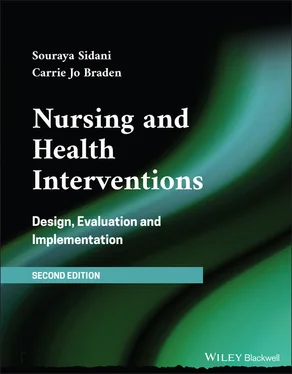1 ...7 8 9 11 12 13 ...26 57 Mayne, J. (2015). Useful theory of change models. The Canadian Journal of Program Evaluation, 30(2), 119–142.
58 McLeod, M., Michie, S., Roberts, I., et al. (2014) Biomedical research: Increasing value, reducing waste. Lancet, 383(9912), 101–104.
59 McNeil, H., Elliot, J., Huson, K., et al. (2016) Engaging older adults in healthcare research and planning: A realist synthesis. Research Involvement and Engagement, 2, 10–27.
60 Medical Research Council (2019) Developing and Evaluating Complex Interventions. Author. www.mrc.ac.uk/complexinterventionsguidance
61 Mockford, C., Staniszewska, S., Griffiths, F., & Herron‐Marx, S. (2012) The impact of patient and public involvement in UK NHS health care: A systematic review. International Journal of Quality in Health Care, 24(1), 28–38.
62 Montague, S. (2019) Does your implementation fit your theory of change? Canadian Journal of Program Evaluation/La Revue canadienne d'évaluation de programme, 33(3), 316–335.
63 Moore, G.F., Evans, R., Hawkins, J., et al. (2019) From complex social interventions to interventions in complex social systems: Future directions and unresolved questions for intervention development and evaluation. Evaluation, 25(1), 23–45
64 Morin, C.M., Beaulier‐Bonneau, S., Ivers, H., et al. (2014) Speed and trajectory of changes of insomnia symptoms during acute treatment with cognitive‐behavioral therapy, singly and combined with medication. Sleep Medicine, 15(6), 701–707.
65 Muscat, D.M., Morony, S., Shepherd, H.L., et al. (2015) Development and field testing of a consumer shared decision‐making program for adults with low literacy. Patient Education and Counseling, 98, 1180–1188.
66 Netto, G., Bohpal, R., Leberle, N., et al. (2010) How can health promotion interventions be adapted for minority ethnic communities? Five principles for guiding the development of behavioural interventions. Health Promotion International, 25(2), 248–257.
67 Pereira, T.V. & Ioannidis, J.P. (2011) Statistically significant meta‐analyses of clinical trials have modest credibility and inflated effects. Journal of Clinical Epidemiology, 64, 1060–1069.
68 Powell, S. (2019) Theories of change: Making value‐explicit. Journal of MultiDisciplinary Evaluation, 15(32), 37–52.
69 Powell, B.J., Beidas, R.S., Lewis, C.C., et al. (2017) Methods to improve the selection and tailoring of implementation strategies. Journal of Behavioral Health Services and Research, 44(2), 177–194.
70 Prestwich, A., Sniehotta, F. F., Whittington, C., et al. (2014) Does theory influence the effectiveness of health behavior interventions? Meta‐analysis. Health Psychology, 33(5), 465–474.
71 Radhakrishan, K. (2012) The efficacy of tailored interventions for self‐management outcomes of type 2 diabetes, hypertension or heart disease: A systematic review. Journal of Advanced Nursing, 68(3), 496–510.
72 Reeve, J., Cooper, L., Harrington, S., et al. (2016) Developing, delivering and evaluating primary mental health care: The co‐production of a new complex intervention. BMC Health Services Research, 16, 470–483.
73 Ren, J., Li, Q., Zhang, T., et al. (2019) Perceptions of engagement in health care among patients with tuberculosis: A qualitative study. Patient Preference and Adherence, 13, 107–117.
74 Renzoto, A.M.W., Romios, P., Crock, C., & Sφnderlund, A.L. (2013). The effectiveness of cultural competence program in ethnic minority patient‐centered health care—A systematic review of the literature. International Journal of Quality in Health Care, 25(3), 261–269.
75 Richards, K.C., Enderlin, C.A., Beck, C., et al. (2007) Tailored biobehavioral interventions: A literature review and synthesis. Research and Theory for Nursing Practice: An international Journal, 21(4), 271–282.
76 Sackett, D.L., Richardson, W.S., Rosenberg, W.M., & Haynes, R.B. (1997) Evidence‐Based Medicine: How to Practice and Teach EBM. Churchill Livingstone, New York.
77 Shadish, W.R., Cook, T.D., & Campbell, D.T. (2002) Experimental and Quasi‐Experimental Design for Generalized Causal Inference. Houghton‐Mifflin, Boston, MA.
78 Shay, L.A. & Lafata, J.E. (2014). Understanding patient perceptions of shared decision making. Patient Education & Counseling, 96, 295–301.
79 Sidani, S. (2015) Health Intervention Research: Advances in Research Design and Methods. Sage, London, UK.
80 Sidani, S. & Fox, M. (2014) Patient‐centered care: A clarification of its active ingredients. Journal of Interprofessional Care, 28(2), 134–141.
81 Sidani, S., Fox, M., & Esptein, D.R. (2017) Contribution of treatment acceptability to acceptance of randomization: An exploration. Journal of Evaluation in Clinical Practice, 23(1), 14–20.
82 Sidani, S., Epstein, D.R., Miranda, J., & Fox, M. (2018) Psychometric properties of the treatment perception and preferences scale. Clinical Nursing Research, 27(6), 743–761.
83 Skivington, K., Matthews, L., Simpson, P.C., & Moore, L. (2018) Developing and evaluating complex interventions: Updating Medical Research Council guidance to take account of new methodological and theoretical approaches. The Lancet, 392(2), S2.
84 Spenceley, S.M., O'Leary, K.A., Chizawsky, L.L.K., et al. (2008) Sources of information used by nurses to inform practice. An integrative review. International Journal of Nursing Studies, 45, 954–970.
85 Stacey, D. & Légaré, F. (2015). Engaging patients using an interprofessional approach to shared decision making. Canadian Oncology Nursing Journal/Revue canadienne de soins infirmiers en oncologie, 25(4), 455–461.
86 Staniszewska, S., Crowe, S., Badenoch, D., et al. (2010) The PRIME project: Developing a patient evidence‐base. Health Expectations, 13, 312–322.
87 Van Belle, S., Wong, G., Westrop, G. et al. (2016) Can “realist” randomised controlled trials be genuinely realist? BMC Trials, 17, 313
88 Van Belle, E., Giesen, J., Conroy, T. et al. (2019) Exploring person‐centred fundamental nursing care in hospital wards: A multi‐site ethnography. Journal of Clinical Nursing, 29(11–12), 1933–1944.
89 Vijn, T.W., Wollersheim, H., Faber, M.J., et al. (2018) Building a patient‐centered and interprofessional training program with patients, students and care professional: Study protocol of a participatory design and evaluation study. BMC Health Services Research, 13, 387–398.
90 Westfall, J.M., Mold, J., & Fagnan, L. (2009. Practice‐based research—“Blue highways” on the NIH roadmap. JAMA, 297(4), 403–406.
CHAPTER 2 Overview of Interventions
For health interventions to be appropriate, acceptable, effective, safe, and efficient, they should be carefully designed. Designing interventions rests on an awareness of what constitutes interventions. This chapter presents a definition of interventions that distinguishes it from related terms (e.g. strategies, programs). The interventions' elements (goals and components) and characteristics (mode, structure, dose) are clarified and described. The elements and characteristics are taken into account when developing, operationalizing, delivering, evaluating, and implementing interventions.
2.1 DEFINITION OF INTERVENTIONS
In the health‐related literature, different terms are used to reflect health professionals' practices or services they provide to clients: strategies, interventions, treatments, techniques, therapies, complex or multicomponent interventions, and programs. These terms are not necessarily interchangeable. There is a distinction between strategies; interventions (including treatments, techniques, therapies); and programs (including complex or multicomponent interventions).
A strategy refers to a general conceptual approach to address a health problem. It is derived from and consistent with the conceptualization of the health problem requiring remediation. A strategy is used to frame the overall design of an intervention. For instance, conceptualizing chronic insomnia from a cognitive perspective only (Harvey et al., 2007) highlights the need for a cognitive approach for intervention. The cognitive approach focuses on information processing (e.g. beliefs about factors contributing to and consequences of insomnia). In contrast, viewing chronic insomnia as a behavioral problem (e.g. Bootzin & Epstein, 2011) indicates the need for a behavioral approach for intervention. The behavioral approach focuses on sleep‐related behaviors and habits. As such, a strategy offers general principles to guide the selection and/or design of interventions that are commensurate with the overarching conceptualization of the health problem.
Читать дальше












